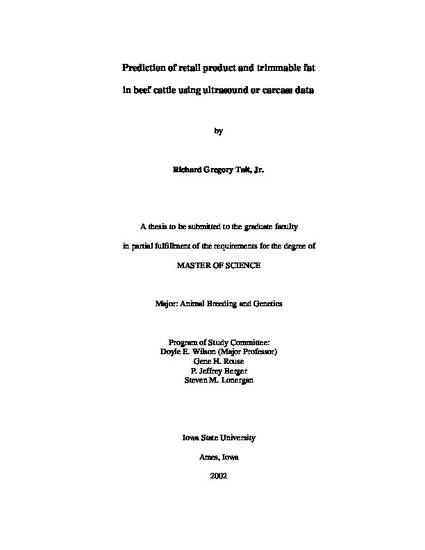
The most widely used system to predict percent retail product from the four primals in beef cattle is USDA yield grade. The purpose of this study was to determine if routine ultrasound measurements and additional rump measurements could be used to more accurately predict the percent lean from the four primals than the carcass measurements going into the USDA yield grade equation. This study utilized market cattle (n = 471) consisting of Angus bulls, Angus steers, and crossbred steers. The right side of each carcass was fabricated into retail cuts, lean trim, fat, and bone; weights of each component were recorded. Percent retail product from the four primals was then expressed as a percentage of side weight. Traditional carcass measures collected were: 1) hot carcass weight (HCW), 2) 12-13th rib fat thickness (CFAT), 3) 12-13th rib ribeye area (CREA), and 4) percent kidney, pelvic, and heart fat (KPH). Live animal ultrasound measures collected within seven days prior to harvest were: 1) scan weight (SCANWT), 2) 12-13th rib fat thickness (UFAT), 3) 12- 13th rib ribeye area (UREA), 4) subcutaneous fat thickness over the termination of the biceps femoris in the rump(reference point) (URFAT), 5) depth of gluteus medius under the reference point (URDEPTH), and 6) area of gluteus medius anterior to the reference point (URAREA). A stepwise regression was performed to develop models to predict percent retail product from the four primals based on carcass measures or ultrasound measures, and comparisons were made between the models. Significant measures (P < 0.001) for the carcass data were CFAT, KPH, and CREA with a model R2 = 0.297. Significant measures (P < 0.001) for the ultrasound data were UFAT, UREA, SCANWT, URDEPTH with a model R2 = 0.448. This study also validated 10 equations which had been either previously reported (n = 8), or modified (n = 2) from a previously reported equation to predict percent retail product in beef cattle. Validation of these equations included reporting R2, root mean squared error, and P-value for each equation.
Available at: http://works.bepress.com/rich_tait_jr/21/
